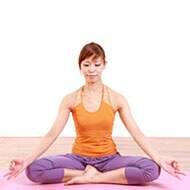Yoga Bandhas - Types, Benefits and Precautions
The word Bandha means hold or lock in Sanskrit. Yoga Bandhas are an integral part of yogic practice.
These play a prominent role in the practice of Hatha Yoga. A Bandha is essentially a static posture which constricts a certain part of the body thereby re-directing the flow of blood and lymph to other parts.
In addition it also helps to provide a gentle massage to certain internal organs.
Benefits of Yoga Bandhas
Let us take a look at some of the ways in which utilizing Yoga Bandhas can enhance the benefits that you gain from the practice of yoga:
- Understanding and utilizing the appropriate Bandhas can simplify the performance of complex yoga poses.
- When you make use of these yoga Bandhas, you also amplify the benefits that the practice of yoga grants your body.
- Bandhas help you to control and improve the function of your body’s internal organ systems such as the nervous system, digestive system, reproductive system, and hormonal system.
- The practice of yoga Bandhas will also allow you to increase the duration for which you hold your postures.
Precautions
Bandhas are a very powerful tool in yoga. They provide a number of benefits if performed in the proper manner, but conversely, if not performed properly, they can prove detrimental in the long run. Hence, it is important to learn the proper method for performing a yoga Bandha from your yoga teacher.He or she will also be able to demonstrate the best method to incorporate the Bandha into your yoga asanas. Yoga bandhas should also not be practiced by pregnant women.
Type of Bandhas
There are three basic types of yoga bandhas—the Mula Bandha, Uddiyana Bandha, and Jalandhara Bandja. These different yoga bandhas can also be combined into the Maha Bandha.
Mula Bandha
The word Mula means root. Thus, the Mula Bandha is the most basic of all the Bandhas. It is also the easiest of yoga bandhas to master. This Bandha can be performed in any of the yoga postures, whether standing, sitting, or supine. In order to perform this Bandha, you should contract the perineum—the area between your anus and genital organs.
Engaging the Mula Bandha allows you to perform your yoga practice for longer without getting fatigued. It also makes you feel lighter on your feet, thereby making the other asanas easier to perform. Performing the Mula Bandha also stimulates the digestive, excretory and reproductive system. It can also help with digestive ailments and is also good for treating depression.
Uddiyana Bandha
The Uddiyana Bandha means flying lock. This refers to the fact that by practicing this Bandha, you direct the energy in your body upwards. In order to practice this Bandha, stand up straight with your feet slightly apart. Inhale and lift your arms straight up over your head. Exhale and bend forward from the back and place your hands just above the knees to support the body.
Hold your breath on the exhale as you straighten your arms and arch your back so that your abdominal organs are pushed upwards towards your back. You know you are performing the Uddiyana Bandha properly when your ribs protrude outwards while your abdominal section is sucked in towards your back.
Engaging the Uddiyana Bandha makes inverted postures and airborne exercises easier. In addition to strengthening and massaging the abdominal organs, it also stimulates the muscles of the lower back. The Uddiyana Bandha is one of the best exercises for the entire digestive system and can help to cure a wide variety of digestive ailments. It also stimulates the adrenal system. If you are looking for washboard abdominals, the Uddiyana Bandha is also a great exercise.
Jalandhara Bandha
The Jalandhara Bandha is a throat lock that is performed in conjunction with breathing exercises. To perform this lock, sit in the Padma Asana or Lotus Pose. Now inhale slowly as you bring your chin towards your chest. Try to maintain this posture while holding your breath as you try to further deepen the lock by straightening your elbows and trying to tuck your chin into your throat. You should be able to feel a double chin forming when you practice this posture correctly. To come out of this lock inhale some more, slowly lift your chin back to the normal position and then exhale.
The Jalandhara Bandha is one of the best yoga bandhas for relieving stress. It also helps to stimulate the circulatory and respiratory systems and is beneficial for those who suffer from respiratory disorders.
Maha Bandha
The Maha Bandha or Great Lock is so called because it combines all three of the previously mentioned Bandhas into one comprehensive exercise. The Maha Bandha should only be attempted once you have mastered the Uddiyana Bandha, Jalandhara Bandha, and Mula Bandha individually. This Bandha is also performed in the Lotus Pose. While sitting in the Lotus Pose inhale deeply and then try to exhale all the breath out of your body. Hold the exhale and first engage the Mula Bandha. Once you have done so, attempt to engage the Uddiyana Bandha while sitting in the same posture. Now inhale slowly to expand your chest and engage the Jalandhara Bandha.
The Maha Bandha provides the benefits of all three of the Yoga Bandhas. It increases your stamina and endurance and also helps to balance the endocrine system.
 Find Pose
Find Pose

